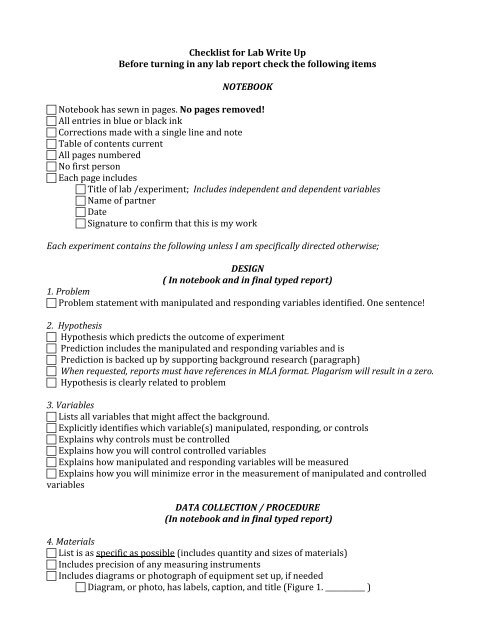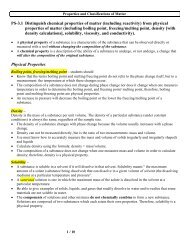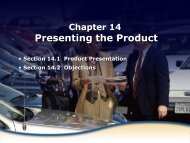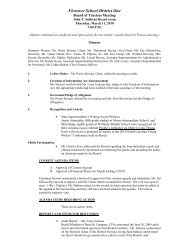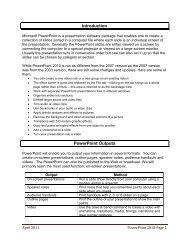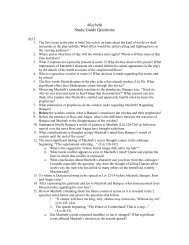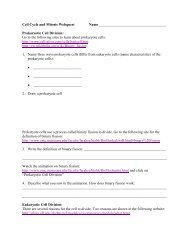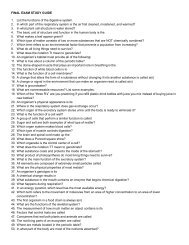Checklist for Lab Write Up Before turning in any lab report check the ...
Checklist for Lab Write Up Before turning in any lab report check the ...
Checklist for Lab Write Up Before turning in any lab report check the ...
You also want an ePaper? Increase the reach of your titles
YUMPU automatically turns print PDFs into web optimized ePapers that Google loves.
<strong>Checklist</strong> <strong>for</strong> <strong>Lab</strong> <strong>Write</strong> <strong>Up</strong><br />
Be<strong>for</strong>e <strong>turn<strong>in</strong>g</strong> <strong>in</strong> <strong>any</strong> <strong>lab</strong> <strong>report</strong> <strong>check</strong> <strong>the</strong> follow<strong>in</strong>g items<br />
NOTEBOOK<br />
Notebook has sewn <strong>in</strong> pages. No pages removed!<br />
All entries <strong>in</strong> blue or black <strong>in</strong>k<br />
Corrections made with a s<strong>in</strong>gle l<strong>in</strong>e and note<br />
Table of contents current<br />
All pages numbered<br />
No first person<br />
Each page <strong>in</strong>cludes<br />
Title of <strong>lab</strong> /experiment; Includes <strong>in</strong>dependent and dependent variables<br />
Name of partner<br />
Date<br />
Signature to confirm that this is my work<br />
Each experiment conta<strong>in</strong>s <strong>the</strong> follow<strong>in</strong>g unless I am specifically directed o<strong>the</strong>rwise;<br />
DESIGN<br />
( In notebook and <strong>in</strong> f<strong>in</strong>al typed <strong>report</strong>)<br />
1. Problem<br />
Problem statement with manipulated and respond<strong>in</strong>g variables identified. One sentence!<br />
2. Hypo<strong>the</strong>sis<br />
Hypo<strong>the</strong>sis which predicts <strong>the</strong> outcome of experiment<br />
Prediction <strong>in</strong>cludes <strong>the</strong> manipulated and respond<strong>in</strong>g variables and is<br />
Prediction is backed up by support<strong>in</strong>g background research (paragraph)<br />
When requested, <strong>report</strong>s must have references <strong>in</strong> MLA <strong>for</strong>mat. Plagarism will result <strong>in</strong> a zero.<br />
Hypo<strong>the</strong>sis is clearly related to problem<br />
3. Variables<br />
Lists all variables that might affect <strong>the</strong> background.<br />
Explicitly identifies which variable(s) manipulated, respond<strong>in</strong>g, or controls<br />
Expla<strong>in</strong>s why controls must be controlled<br />
Expla<strong>in</strong>s how you will control controlled variables<br />
Expla<strong>in</strong>s how manipulated and respond<strong>in</strong>g variables will be measured<br />
Expla<strong>in</strong>s how you will m<strong>in</strong>imize error <strong>in</strong> <strong>the</strong> measurement of manipulated and controlled<br />
variables<br />
DATA COLLECTION / PROCEDURE<br />
(In notebook and <strong>in</strong> f<strong>in</strong>al typed <strong>report</strong>)<br />
4. Materials<br />
List is as specific as possible (<strong>in</strong>cludes quantity and sizes of materials)<br />
Includes precision of <strong>any</strong> measur<strong>in</strong>g <strong>in</strong>struments<br />
Includes diagrams or photograph of equipment set up, if needed<br />
Diagram, or photo, has <strong>lab</strong>els, caption, and title (Figure 1. ___________ )
5. Procedure<br />
An easy to follow series of steps<br />
Steps are detailed enough that someone could repeat <strong>the</strong> experiment and get very similar<br />
results<br />
Includes which quantitative and qualitative data must be recorded.<br />
Describes how data is to be measured;<br />
Includes at least 5 repetitions of 5 trials [<strong>for</strong> <strong>for</strong>mal plann<strong>in</strong>g <strong>lab</strong>]<br />
Does not <strong>in</strong>clude “Ga<strong>the</strong>r materials” or “ Clean up”<br />
Includes important disposal <strong>in</strong>structions <strong>for</strong> <strong>any</strong> hazardous chemicals used<br />
6. Safety*<br />
List <strong>any</strong> safety precautions that might be needed<br />
7. Environmental*<br />
Expla<strong>in</strong> <strong>the</strong> steps you will take to m<strong>in</strong>imize negative effects on <strong>the</strong> environment.<br />
*If no precautions are needed say so and tell why<br />
DATA COLLECTION<br />
(In notebook and f<strong>in</strong>al typed <strong>report</strong>)<br />
8. Data presentation – If you make a graph or table you must discuss it <strong>in</strong> your <strong>report</strong>!<br />
Data is legible and organized<br />
Tables<br />
Data should be presented <strong>in</strong> tables whenever possible<br />
Table has a “stand alone” descriptive title<br />
Tables are numbered sequentially (Table 1. ______; Table 2. _____)<br />
Tables use standard <strong>for</strong>mat<br />
column 1 – manipulated variable<br />
column 2 or more – repetitions of respond<strong>in</strong>g variable<br />
column head<strong>in</strong>gs <strong>in</strong>clude units and precision<br />
accuracy of a measur<strong>in</strong>g device is 1/2 of <strong>the</strong> smallest measurement possible<br />
Tables of processed data (data that has been ma<strong>the</strong>matically manipulated <strong>in</strong> some way) are<br />
separate from tables of raw data and summarize raw data<br />
Calculations<br />
One sample calculation shown <strong>for</strong> each type of calculation<br />
Sample calculation <strong>in</strong>cludes <strong>any</strong> necessary <strong>for</strong>mula, units, appropriate sig. figs.<br />
Sample calculation <strong>lab</strong>eled<br />
Results only <strong>for</strong> <strong>the</strong> rema<strong>in</strong>der of similar calculations<br />
Graphs (Mostly <strong>for</strong> Physics this year)<br />
Graph has a statement title<br />
Graphs are numbered sequentially ( Graph 1. ________; Graph 2_________)<br />
Manipulated variable on <strong>the</strong> X- axis; Respond<strong>in</strong>g variable on <strong>the</strong> Y axis<br />
Axes have <strong>lab</strong>els, units, and precision
Best fit curve with error bars NO dot-to-dot l<strong>in</strong>es!<br />
(See l<strong>in</strong>ks to <strong>in</strong>structions <strong>for</strong> Excel or Graph<strong>in</strong>g Calculators on Resource Page)<br />
Equation <strong>for</strong> best fit l<strong>in</strong>e whenever possible<br />
r 2 value (show fit of l<strong>in</strong>e)<br />
CONCLUSIONS<br />
May be <strong>in</strong> bulleted list and T- chart’s <strong>in</strong> Notebook<br />
Must be <strong>in</strong> paragraph <strong>for</strong>m <strong>in</strong> f<strong>in</strong>al typed <strong>report</strong><br />
9. Conclusions<br />
One or more paragraphs stat<strong>in</strong>g your conclusion<br />
Expla<strong>in</strong> whe<strong>the</strong>r <strong>the</strong> hypo<strong>the</strong>sis is supported or not. You cannot prove that your<br />
hypo<strong>the</strong>sis is correct.<br />
Explanation is supported by experimental data<br />
If a standard value is avai<strong>lab</strong>le, percent error must be calculated and discussed.<br />
Do not attempt to talk about data that isn’t recorded <strong>in</strong> <strong>the</strong> previous section<br />
10. Limitations<br />
Expla<strong>in</strong> level of uncerta<strong>in</strong>ty – How large is your error<br />
Table list<strong>in</strong>g sources of error due to procedure or materials, <strong>the</strong>ir effect on <strong>the</strong> variables and<br />
conclusions, and realistic fixes <strong>for</strong> <strong>the</strong>se sources of error<br />
Human error just means that you didn’t plan appropriately or that you have poor technique.<br />
Every weakness must have a realistic suggested fix!<br />
11. Extensions<br />
Offer suggestions <strong>for</strong> fur<strong>the</strong>r research on this or a related topic. This does not mean<br />
more trials, it means what questions has this experiment made you ask.<br />
Were you able to <strong>check</strong> all of <strong>the</strong> assigned boxes<br />
Turn it <strong>in</strong>. You are probably <strong>in</strong> good shape.<br />
Do you have questions Ask <strong>the</strong>m up through <strong>the</strong> day be<strong>for</strong>e <strong>the</strong> <strong>lab</strong> <strong>report</strong> is due and I will<br />
do my best to po<strong>in</strong>t you toward a solution.<br />
On <strong>the</strong> day it is due – too late. Turn it <strong>any</strong>way to avoid <strong>any</strong> fur<strong>the</strong>r reduction <strong>in</strong> po<strong>in</strong>ts.


